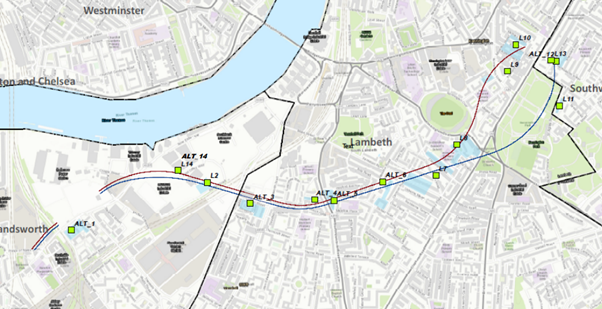Ground-borne noise is generated by underground railways as illustrated in the figure below. As the train passes, vibration is transmitted into the tunnel structure then into the ground around the tunnel ‘ring’, then from the ground into the foundations of buildings. From there, vibration is transmitted through the building structure and radiated from the walls and floors as ‘ground-borne noise’.
Figure 1 – ground-borne noise transmission from underground railways

The ground-borne noise is a ‘rumbling’ noise which can lead to effects such as being distracting, annoying and disturbing sleep. When designing a new underground railway, an assessment of the likelihood of these effects occurring is carried out. This assessment requires predictions of the ground-borne noise level to be compared to noise level thresholds at which these effects are likely to occur.
There is uncertainty in all noise predictions. Areas of uncertainty in ground-borne noise predictions can include, for example, how rough the rails are, train speeds, ground type and the type of foundations of existing buildings. Due to the uncertainty, worst-case assumptions are often made as the variation between predicted noise levels and measured noise levels can be quite substantial and measured noise levels may be 10dB lower than worst-case predictions.
The northern line extension (NLE) is an extension of the Charing Cross branch of the Northern line comprising two new 3.2km running tunnels joining the existing network at Kennington and terminating at Battersea Power Station including two new stations at Nine Elms and Battersea Power Station.
NLE was granted a Transport and Works Act order (TWAO) in November 2014. The TWAO had conditions which required ground-borne noise levels to be below 35dB LAFmax in dwellings. Predictions were carried out for the NLE using worst-case assumptions which demonstrated that, with a low-vibration track, limits were unlikely to be exceeded.
The TWAO also required measurements to be taken to demonstrate compliance with this requirement. Monitoring such as this is useful to provide reassurance in the face of uncertainty and demonstrate compliance with limits or requirements.
Just before the NLE opening in September 2021, Temple undertook monitoring of the ground-borne noise levels in 15 dwellings and 24 different rooms along the NLE route.
Figure 2 – measurement locations (green squares) along NLE route (red and blue lines).

Measurements were generally taken directly using a microphone and sound level meter. In a few cases where the background noise level from other sources (e.g. road traffic outside the window of the dwelling) was high, and the train noise was too quiet to be measured, measurements were also taken indirectly. This was done using an accelerometer and vibration meter which measured the vibration level in the floor; this was then extrapolated to give a likely ground-borne noise level in the room due to this vibration.
However, there is also uncertainty in monitoring so Temple needed to account for this to demonstrate that NLE will likely meet the limits in all reasonably foreseeable circumstances with a high confidence. There are two areas of uncertainty for these measurements.
- Firstly, the potential variability between different locations may be represented by the measurements; not all dwellings and rooms in the vicinity of the tunnel can be measured, so it is important to know if there is potential for higher noise levels elsewhere. This was generally minimised by picking dwellings in buildings which were predicted to experience the highest noise levels. However, this does not reduce the uncertainty to zero as there may be variability between rooms particularly due to different floor types (i.e. different floors may resonate differently amplifying different frequencies and giving a different overall noise level) or reverberant conditions in the room (e.g. in a room with hard surfaces and little furniture then the noise reverberates around the room and a higher noise level may be measured).
- Secondly, there is the uncertainty in the measurement itself, for example, based on how precise the equipment is or where in the room the measurement is taken. This was generally minimised by using high precision equipment and undertaking the measurement in the likely worst case location in the room.
The measurements, including an allowance for the uncertainty of around 5dB, found no train pass by which exceeded the 35dB LAFmax criterion at any receptors.
The measurement exercise is a very useful demonstration that while accurate predictions are essential in the design process and to demonstrate what is likely to occur to decision makers, actual measurements of the scheme, as built and operated, greatly improve confidence that acoustic requirements are met.